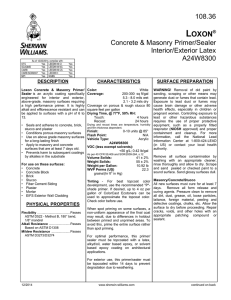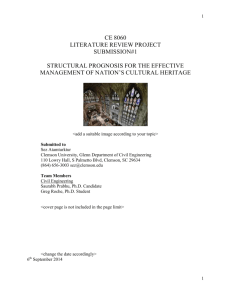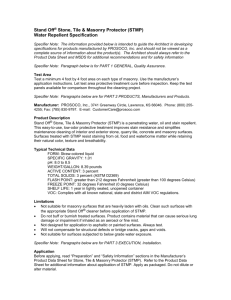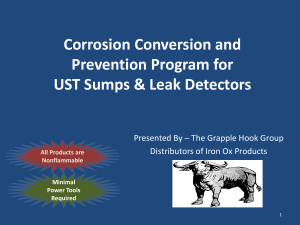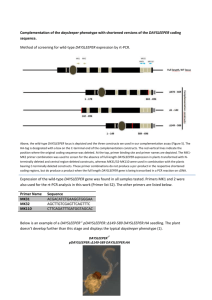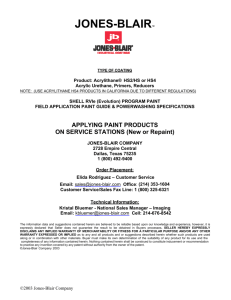Notes on methods and materials that might best be used to prolong
advertisement
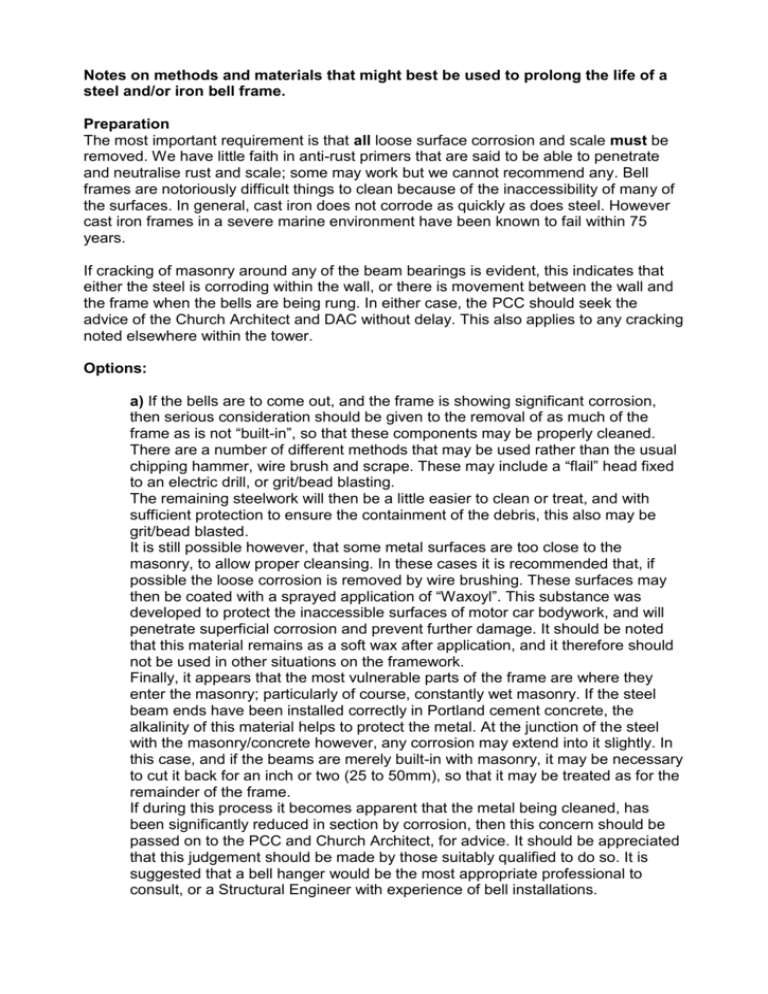
Notes on methods and materials that might best be used to prolong the life of a steel and/or iron bell frame. Preparation The most important requirement is that all loose surface corrosion and scale must be removed. We have little faith in anti-rust primers that are said to be able to penetrate and neutralise rust and scale; some may work but we cannot recommend any. Bell frames are notoriously difficult things to clean because of the inaccessibility of many of the surfaces. In general, cast iron does not corrode as quickly as does steel. However cast iron frames in a severe marine environment have been known to fail within 75 years. If cracking of masonry around any of the beam bearings is evident, this indicates that either the steel is corroding within the wall, or there is movement between the wall and the frame when the bells are being rung. In either case, the PCC should seek the advice of the Church Architect and DAC without delay. This also applies to any cracking noted elsewhere within the tower. Options: a) If the bells are to come out, and the frame is showing significant corrosion, then serious consideration should be given to the removal of as much of the frame as is not “built-in”, so that these components may be properly cleaned. There are a number of different methods that may be used rather than the usual chipping hammer, wire brush and scrape. These may include a “flail” head fixed to an electric drill, or grit/bead blasting. The remaining steelwork will then be a little easier to clean or treat, and with sufficient protection to ensure the containment of the debris, this also may be grit/bead blasted. It is still possible however, that some metal surfaces are too close to the masonry, to allow proper cleansing. In these cases it is recommended that, if possible the loose corrosion is removed by wire brushing. These surfaces may then be coated with a sprayed application of “Waxoyl”. This substance was developed to protect the inaccessible surfaces of motor car bodywork, and will penetrate superficial corrosion and prevent further damage. It should be noted that this material remains as a soft wax after application, and it therefore should not be used in other situations on the framework. Finally, it appears that the most vulnerable parts of the frame are where they enter the masonry; particularly of course, constantly wet masonry. If the steel beam ends have been installed correctly in Portland cement concrete, the alkalinity of this material helps to protect the metal. At the junction of the steel with the masonry/concrete however, any corrosion may extend into it slightly. In this case, and if the beams are merely built-in with masonry, it may be necessary to cut it back for an inch or two (25 to 50mm), so that it may be treated as for the remainder of the frame. If during this process it becomes apparent that the metal being cleaned, has been significantly reduced in section by corrosion, then this concern should be passed on to the PCC and Church Architect, for advice. It should be appreciated that this judgement should be made by those suitably qualified to do so. It is suggested that a bell hanger would be the most appropriate professional to consult, or a Structural Engineer with experience of bell installations. b) If the bells are not to come out, then it is suggested that grit/bead blasting should not be employed because of the restricted access and the danger of the abrasive material finding its way into bearings and rubbing or sliding surfaces. It is recommended however, that the bell wheels, stays, sliders, pulley boxes etc., are removed in order to allow reasonable access to the frame parts. Otherwise, the procedures are as noted above. Re-painting The choice of materials used to repaint the frame is rather less important than the preparation detailed above. There are many specialised coatings available including epoxy resins, and some specifically for use in marine situations. We cannot comment on each of them because of this diversity. It is suggested however that the primer used on the cleaned metal, is the more important part of the system to select. The finish coats are really just there to physically protect the primer. When choosing a paint specification or system, it is essential to ensure that the primer and finish coats are compatible. It is possible that the application of a finish coating to a non-compatible primer, will result in the latter being dissolved and pulled off the surface. One other general suggestion to make the job much easier and to ensure that all surfaces are properly covered, is to choose a light colour for the finish coats. Another point to consider in the selection of a system, is that it will be necessary for the steeple-keeper, and probably other workers too, to crawl all over the frame to carry out maintenance. One should therefore look for a finish that will be hard wearing, will not remain “sticky”, and be relatively non-slip. In the past, bituminous based paints have been used on red-lead primer. Because of this, and the large amount of rust and masonry dust, it is essential that the operatives involved in the cleaning work, carry out a proper written risk assessment and use all relevant working methods and personal protective equipment to minimise health risks. Whichever coating system is chosen, be sure to follow the Health & Safety information/COSHH Statements issued with the material. Lead based primers are not now available and so some other kind of rust inhibiting primer is required. There is a general awareness of a particular brand of paint that is widely sold to the DIY enthusiast, and purports to be a rust inhibitor/neutraliser and finish, all in one. It is our experience that this material is not suitable or adequate for the job of protecting and painting bell frames. Our preferred primer is “Galvafroid”. This should be applied generously and worked into the surface. It is suggested that this may be followed by two coats of a “machine enamel” paint. J.M.C. November 2007.
